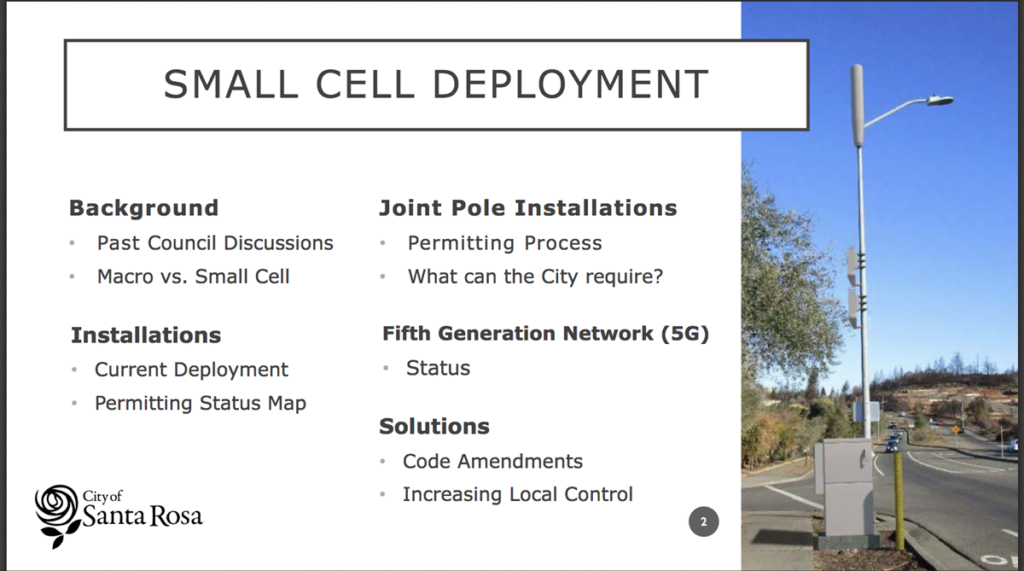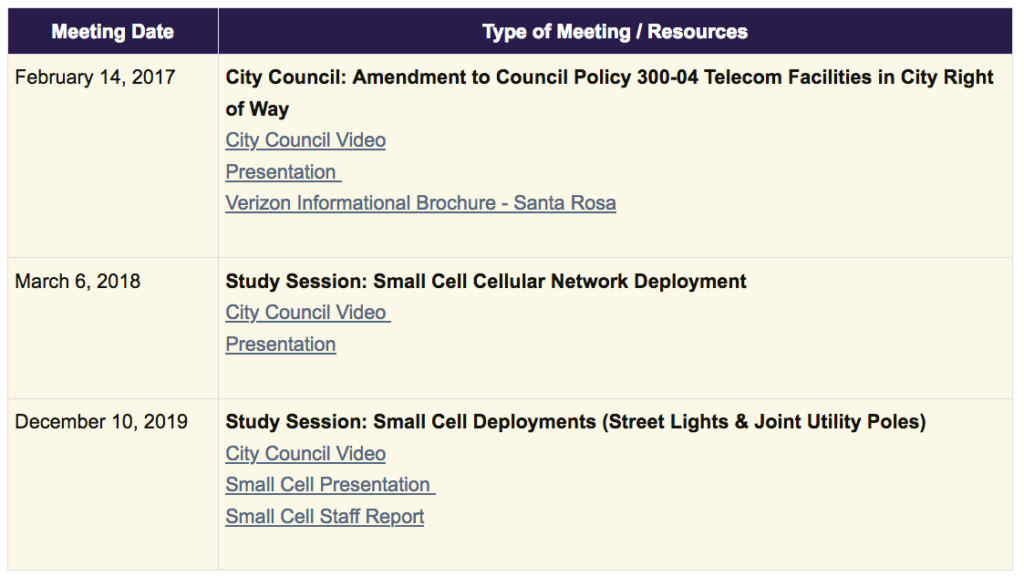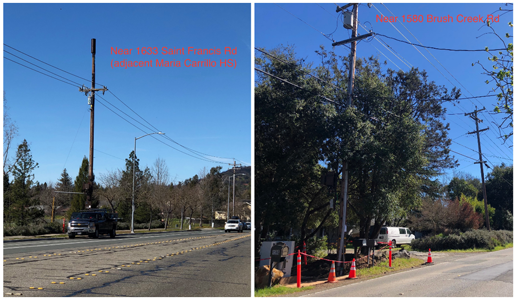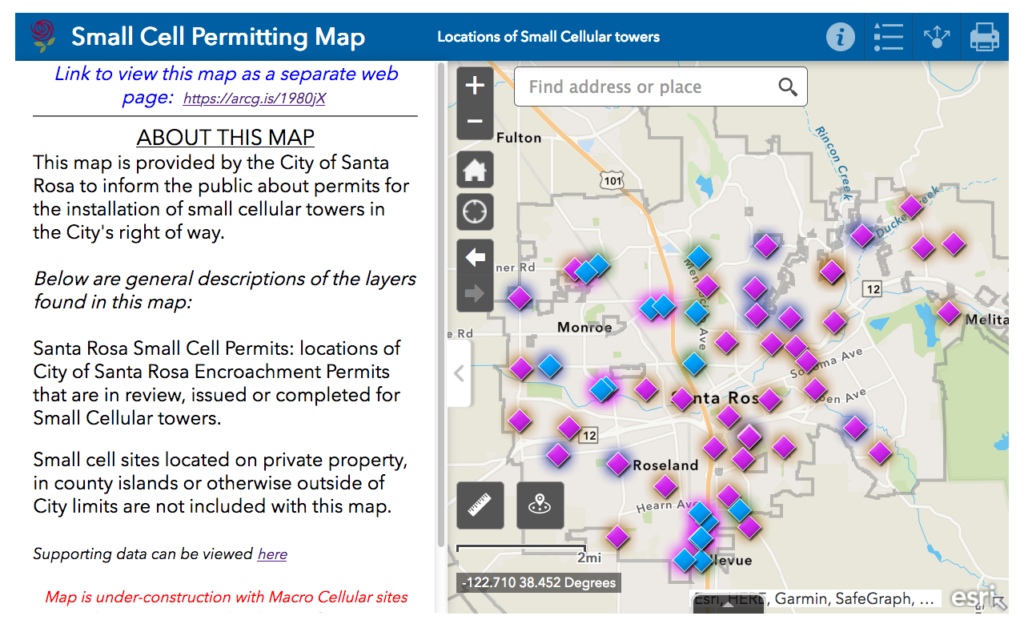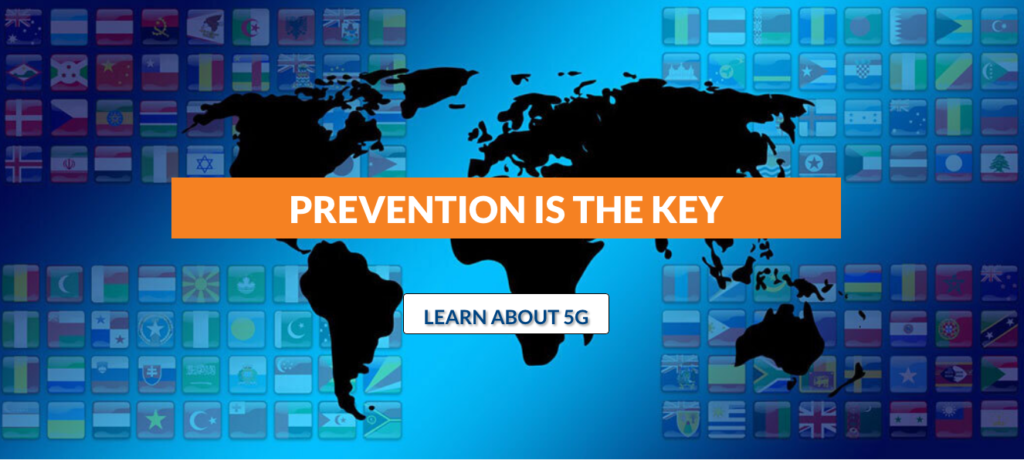Santa Rosa Telecom Ordinance for Small Cell Antennas
Santa Rosa passed Small Cell Ordinance June 29, 2021
The City of Santa Rosa has developed a comprehensive set of codes, standards and submittal requirements associated with the placement of wireless facilities in the public right-of-way. A proposed resolution and ordinance, amending Santa Rosa City Code Title 13 and adopting development standards, was presented and adopted by the City Council on June 29, 2021.
What’s a Small Cell Wireless Facility?
Small Cell facilities are low-powered antennas that provide cellular and data coverage to smaller geographic areas, supplementing the larger cellular network and improving service for wireless customers. Traditionally, wireless antennas and equipment were primarily installed on large towers located on the rooftops of private and public buildings. In recent years, wireless services companies increasingly seek to install small wireless facilities in the public rights-of-way on wooden utility poles, streetlights, and new poles. Current predictions indicate that the next wave of wireless facility deployment (5G) will involve as much as $275 billion in investment over the next decade, with the vast majority of these new facilities anticipated to be placed in the public right-of-way.
The proposed ordinance will focus on the placement, design, installation, construction, maintenance and operation of wireless facilities in the City’s rights-of-way in a manner that considers the aesthetic and public health and safety requirements of the City. The ordinance will also address the type of wireless facilities that are exempt, permitted, conditionally permitted and prohibited within the City’s public right-of-way and place a specific focus on the following areas:
- Ability to amend requirements efficiently.
- Transparency and notice.
- Compliance with shot clocks.
- Appeals.
Note: To read more about the newly adopted Small Cell Ordinance, go to the City website page HERE: and click on the Nine Attachments towards the bottom of the page.
Study Sessions Leading up to the Ordinance Vote
The City of Santa Rosa held its fourth study session on July 21, 2020 to provide an update regarding the current and future deployment of wireless small cell facilities within City limits, as well as potential future modification to cellular facility codes and policies intended to address community concerns.
To access the 7/21/20 Small Cell PP Presentation by Gabe Osborne, Santa Rosa Deputy Director of Developmental Services as well as the public correspondence, click on the slide to the left.
For SafeTech’s response, click the link below under “Safe Tech for Santa Rosa responds to the City at July 21, 2020 Small Cell Study Session”
Previous Small Cell Study Sessions- Feb 14, 2017, March 6, 2018, and December 10, 2019
Purpose of the four study sessions by Santa Rosa City Council:
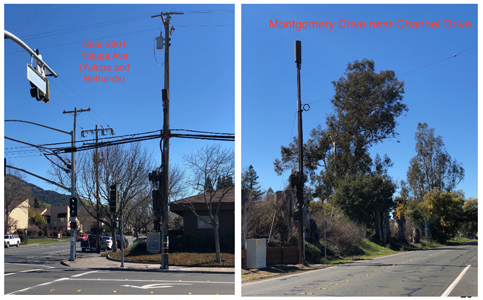
“The City of Santa Rosa is exploring the need for an ordinance to regulate certain aspects of the location, design, and placement of small cell antenna. Small cell antenna (also known as small cells or single small antenna) are small short-range cellular transmitters placed on existing utility poles—mainly steel street lights and wood powerline poles—to provide cellular service for wireless devices such as smart phones, tablets, health monitors, among others.
“In general, there are three types of poles in the public right-of-way in the City that can have small cells attached: (1) PG&E-owned poles, most of which are made of wood; (2) City-owned poles for traffic and street lighting, most of which are made of steel; and (3) those where the City has joint ownership. A small cell ordinance would expand design guidelines, align and improve noticing requirements, streamline the review process, and build a public process to address small cells inclusion on City-owned or joint-owned poles in the CIty.
“Below is a map of City of Santa Rosa Encroachment Permits that are in review, issued or completed for small cellular towers. Small cell sites located in county islands or otherwise outside of City limits are not included with this map.”
Click on the map below to pull up to SR City website for an interactive version.
Safe Tech for Santa Rosa responds to the City at July 21, 2020 Small Cell Study Session
Safe Tech presentation July 21-20
Re: 7/21/2020 Study session item 3.2-WIRELESS SMALL CELL DEPLOYMENTS ON CITY OWNED STREET LIGHTS AND JOINT UTILITY POLES(1)
● Our desire and main objective: We (Santa Rosa for Safe Technology) request the City Council (of Santa Rosa, CA) to direct City (of Santa Rosa, CA) staff to prioritize updating chapters 13 and 20 of the City Code to include Small Cell Technology, with the intention of retaining as much local control to the placement of such facilities consistent with current State and Federal Laws.
● Cities across the U.S. have adopted ordinances that eliminate and/or minimize the numbers of facilities in their cities and which ensure that the installation, augmentation and relocation of personal wireless facilities/small cell antenna in the public rights-of-way are conducted in such a manner as to lawfully balance the legal rights of applicants under the federal Telecommunications Act, the 2012 Middle-Class Tax Relief and Job Opportunities Act, any FCC orders, and the California State Public Utilities Code, and with the rights, safety, privacy, property and security of residents, businesses and visitors of and to Santa Rosa.
For our entire full SafeTech response, click Safe Tech presentation July 21-20
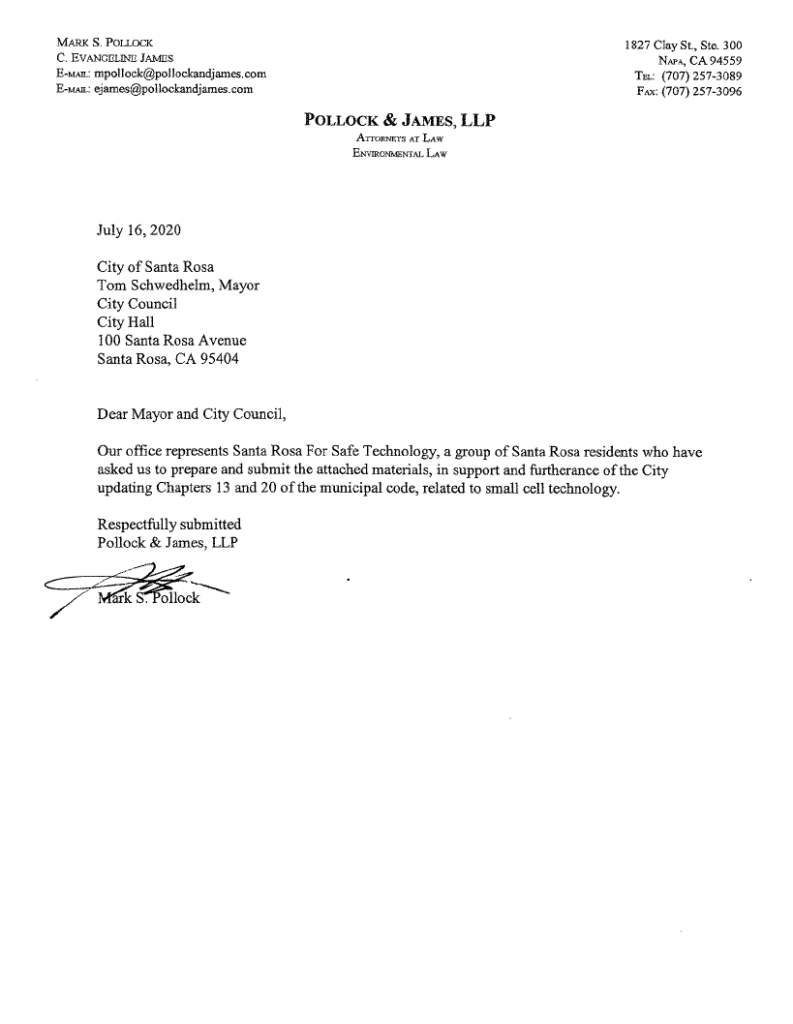
Letter to Santa Rosa City Council from Cindy Lee Russell, MD, Executive Director of Physicians for Safe Technology for the July 21, 2020 Study Session

Cindy Lee Russell, M.D., Executive Director of Physicians for Safe Technology
July 21, 2020
Agenda item 3.2
Dear Santa Rosa Mayor and City Council,
I am a physician and a mother. I ask that you pass the strongest emergency ordinance possible to protect the health, safety and privacy of the citizens of Santa Rosa as well as to preserve your local control.
After training at Stanford I have for over 20 years studied and developed policy resolutions to reduce environmental toxins through our local county medical association and the California medical Association. This includes flame retardants, BPA, pesticides and fracking, as well as wireless radiation.
When I learned of a proposal to place a cell tower on my daughter’s school 10 years ago I dove into the research. What I learned is that wireless technology, is an environmental and human toxin. We are increasingly surrounded by these wireless devices including, Smart meters, Wi Fi routers, cellphones as well as constantly radiating cell towers. Unfortunately, we are told they are safe ….or that we do not really know if there is harm… or that the research is inconclusive or ….that it is not ionizing (like x-rays) so it cannot possibly hurt us.
However, myself and over 250 expert scientists who have looked at this issue conclude the opposite. Research shows conclusively there is biologic harm from wireless radiation. Low levels of this radiation that are within the current flawed FCC guidelines cause neurologic harm, DNA damage and effects on reproduction,
In 2017 Kaiser physician De-Kun Li performed a study of 913 pregnant women looking at the association of miscarriage with high EMR exposures. He found a 3 fold increase in rates of miscarriage in the higher exposure group. These are everyday exposures of wireless radiation. These exposures are all within current guidelines.
Cell tower studies show an increase in cancer as well as neurologic symptoms in those living within 1500 feet of cell towers
FCC standards for wireless radiation are only based on heat not biologic effects. The mechanism of toxicity of low level wireless radiation is oxidation, not heat, and it is similar to that of DDT and other toxic chemicals we are exposed to that do not cause harm by heating. It causes direct injury to cell membranes and structures .
Cell towers and wireless devices add to the background of toxic exposures. We have the option to eat organic food and turnour cell phones off but we cannot turn a cell tower off at night to have a peaceful sleep, if we are sensitive to the radiation.
There is also cumulative harm with people becoming electrosensitive over time. The development of cancer occurs over years and will not be seen right away. The body repairs the DNA damage as best it can until it is overwhelmed by continuous toxic exposures.
We should not be allowing the expansion of telecommunications through densification of cell towers in our cities. We already know that 2G, 3G and 4G frequencies are harmful. 5G will be a mix of these lower frequencies and higher more powerful frequencies that have not been tested for safety.
We should be altering direction and placing fiberoptic to the premises. This is a safer and more secure solution that is cheaper in the long run and better for cities and citizens.
Thank you.
Comment for Santa Rose City Council Meeting – July 21
I’m calling to make a comment on agenda item number 3.2.
My name is Kurt Cobb. I am program director for SafeG, a nonprofit educational program which seeks to unite those who view 5G as dangerous by giving us a common way to refer to a sane and safe alternative that has greater utility and safeguards our health, privacy and security.
I’m providing a brief overview of that alterative in this comment:
SafeG means safe, fast, reliable, secure internet and telecommunications services brought into our homes and businesses by wired technology. It means technology that safeguards our health, privacy and security and that evolves over time with the goal of reducing exposure to harmful wireless radiation.
The critical element that characterizes SafeG—wired connections to the home or business—is already available to a large number people around the world from existing internet and telecommunications providers, especially in advanced economies. If we focus on extending availability and improving speed and capacity, we can have a safe system that keeps up with changes in technology and provides all the services we desire.
Now here is an essential feature of the SafeG idea: SafeG accepts the right of homeowners and businesses to decide for themselves whether to have wired or wireless networks on their premises but without forcing that choice on others.
Naturally, we favor wired networks inside the home and business because they eliminate wireless radiation and protect our privacy and security better. Such wired connections also tend to be more robust and reliable, offering consistent, uninterrupted high-speed data transfer.
While wired connections to the premises are often available from private telecom ISPs, such wired networks lend themselves well to community ownership. Community-owned wired networks typically serve the public with lower-cost, higher-quality internet service. These systems pay for themselves and may even provide enough revenues to subsidize low-income users.
The SafeG option, whether implemented by private industry or the municipality itself, provides superior bandwidth as well as a safer environment for all of us.
The find out more about the SafeG option, you may visit our site at safeg.net, that is, the word safe plus the letter “g” as in good, all one word, dot net.
Thank you for your attention.
Letter to Santa Rosa City Council from Theodora Scarato, MSW, Executive Director of Environmental Health Trust for July 21, 2020 Study Session

To Santa Rosa City Council re: Council Number 3.2 study session, July 21, 2020, Comment of Theodora Scarato, MSW (Note: Photo elements added by SafeTech4SantaRosa)
We Must Consider the Environmental Footprint of the Digital Ecosystem.
Engineers say 5G is “an energy hog.” The millions of new short “small” cell towers and over 64 billion IoT devices are expected by 2025. Industry reports repeatedly state that energy efficiency goals will not be fully met, and that energy use from wireless devices and networks will grow exponentially, ever increasing our carbon footprint . Environmental experts warn that the IOT is 12345 an unsustainable technology and will contribute to climate change.
“Behind each byte we have mining and metal processing, oil extraction and petrochemicals, manufacturing and intermediate transports, public works (to bury the cables) and power generation with coal and gas. As a result, the carbon footprint of the global digital system is already 4% of the global greenhouse gas emissions, and it’s energy consumption rises by 9% per year.”
– Jean-Marc Jancovici, President of The Shift Project, member of the French High Climate Council –
“Lean ICT: Towards Digital Sobriety: Report on the Environmental Impact of Information and Communication Technologies, February 2019.
I am also submitting to you the July 8, 2020 letter to me from from the Environmental Protection Agency Lee Ann B. Veal, Director, Radiation Protection Division, Office of Radiation and Indoor Air which confirms that they have never reviewed the impact to birds, bees or trees. There is no federal health agency that has ever set safety limits for trees or bees. Our outdated wireless radiation limits were never intended to protect birds, bees and trees. No agency even has a funded mandate to ensure our flora and fauna are safe from cell tower radiation. In other words it is a gaping hole in federal accountability.

Documented Impacts to Wildlife and the Environment
● “A review of the ecological effects of RF-EMF” reviewed 113 studies finding RF-EMF had a significant effect on birds, insects, other vertebrates, other organisms and plants in 70% of the studies (Cucurachi 2013). Development and reproduction in birds and insects were the most strongly affected. As an example of the several studies on wildlife impacts, a study focusing on RF from antennas found increased sperm abnormalities in mice exposed to RF from GSM antennas (Otitoloju 2010) .
● “Exposure of Insects to Radio-Frequency Electromagnetic Fields from 2 to 120 GHz ” published in Scientific Reports is the first study to investigate how insects (including the Western honeybee) absorb the higher frequencies (2 GHz to 120 GHz) to be used in the 4G/5G rollout. The scientific simulations showed increases in absorbed power between 3% to 370% when the insects were exposed to the frequencies. Researchers concluded, “This could lead to changes in insect behaviour, physiology, and morphology over time….”
● Studies on bees have found behavioral effects (Kumar 2011, Favre 2011), disrupted navigation Goldsworthy 2009, Sainudeen 2011 , Kimmel et al. 2007 ) decreasing egg laying rate (Sharma and Kumar, 2010 ) and reduced colony strength (Sharma and Kumar, 2010 , Harst et al. 2006 ).
● Research has also found a high level of damage to trees from antenna radiation. For example, a field monitoring study spanning 9 years involving over 100 trees ( Waldmann-Selsam 2016) found trees sustained more damage on the side of the tree facing the antenna.

● A study on Aspen trees near Lyons, Colorado entitled “Adverse Influence of Radio Frequency Background on Trembling Aspen Seedlings ” published in the International Journal of Forestry found adverse effects on growth rate and fall anthocyanin production concluding that, “results of this preliminary experiment indicate that the RF background may be adversely affecting leaf and shoot growth and inhibiting fall production of anthocyanins associated with leaf senescence in trembling aspen seedlings. These effects suggest that exposure to the RF background may be an underlying factor in the recent rapid decline of aspen populations. Further studies are underway to test this hypothesis in a more rigorous way.”
● An analysis of 45 peer-reviewed scientific publications (1996-2016) on changes in plants due to the non-thermal RF-EMF effects from mobile phone radiation entitled “ Weak radiofrequency radiation exposure from mobile phone radiation on plants concludes, “Our analysis demonstrates that the data from a substantial amount of the studies on RF-EMFs from mobile phones show physiological and/or morphological effects (89.9%, p < 0.001). Additionally, our analysis of the results from these reported studies demonstrates that the maize, roselle, pea, fenugreek, duckweeds, tomato, onions and mungbean plants seem to be very sensitive to RF-EMFs. Our findings also suggest that plants seem to be more responsive to certain frequencies…”
What we have is a gaping hole in accountability on this issue.
The U.S. Department of the Interior sent a letter in 2014 reviewing several research studies showing harm to birds and concluding that “The electromagnetic radiation standards used by the Federal Communications Commission (FCC) continue to be based on thermal heating, a criterion now nearly 30 years out of date and inapplicable today.”
A now retired US Fish and Wildlife Service wildlife biologist, former lead on on telecommunications
impacts, Dr. Albert Manville, has written to the FCC on impacts to birds and higher frequencies to be used in 5G and authored numerous publications detailing research showing harm to birds. He concludes, “The race to implement 5G and the push by FCC to approve the related 5G license frequencies to industry are very troubling and downright dangerous.”

Telecommunications Companies Warn Their Shareholders
In fact, a number of corporations already advise their shareholders that they could face serious financial risks from the health damages due to RF. For instance, Crown Castle’s 2019 10-K ANNUAL REPORT states:
“If radio frequency emissions from wireless handsets or equipment on our communications infrastructure are demonstrated to cause negative health effects, potential future claims could adversely affect our operations, costs or revenues. The potential connection between radio frequency emissions and certain negative health effects, including some forms of cancer, has been the subject of substantial study by the scientific community in recent years. We cannot guarantee that claims relating to radio frequency emissions will not arise in the future or that the results of such studies will not be adverse to us.
“If a connection between radio frequency emissions and possible negative health effects were established, our operations, costs, or revenues may be materially and adversely affected. We currently do not maintain any significant insurance with respect to these matters.
Most wireless companies, from AT&T to Nokia to T Mobile to Verizon Wireless , have issued similar warnings to their shareholders. Why are shareholders being warned but not the people living near the equipment? These disclosures show that even corporations cannot assure safety.
Due to these evaluations and the published scientific evidence, cell phone manufacturers cannot insure against health damages from the radiofrequency radiation emitted by their products and networks. In fact, most insurance plans do not cover electromagnetic fields (EMF) and have very clear “electromagnetic field exclusions.” In order for insurance companies to cover EMF, one often must purchase additional “Pollution Liability” or “Policy Enhancement” coverage.
According to CFC Underwriting LTD in London, the UK agent for Lloyd’s:
“The Electromagnetic Fields Exclusion (Exclusion 32) is a General Insurance Exclusion and is applied across the market as standard. The purpose of the exclusion is to exclude cover for illnesses caused by continuous long-term non-ionizing radiation exposure i.e. through mobile phone usage.”
Even AT&T Mobile Insurance excludes loss from “pollutants” and its policy defines “Pollutants” as “Any solid, liquid, gaseous, or thermal irritant or contaminant including smoke, vapor, soot, fumes, acid, alkalis, chemicals, artificially produced electric fields, magnetic field, electromagnetic field, sound waves, microwaves, and all artificially produced ionizing or non- ionizing radiation and waste,” (pg. 4) AT &T Mobile Insurance Policy, February 2014 .
If insurance companies will not insure EMF and if even telecommunications companies consider EMF is a “pollutant,” how can governments allow such an environmental pollutant without also warning their citizens as companies do?
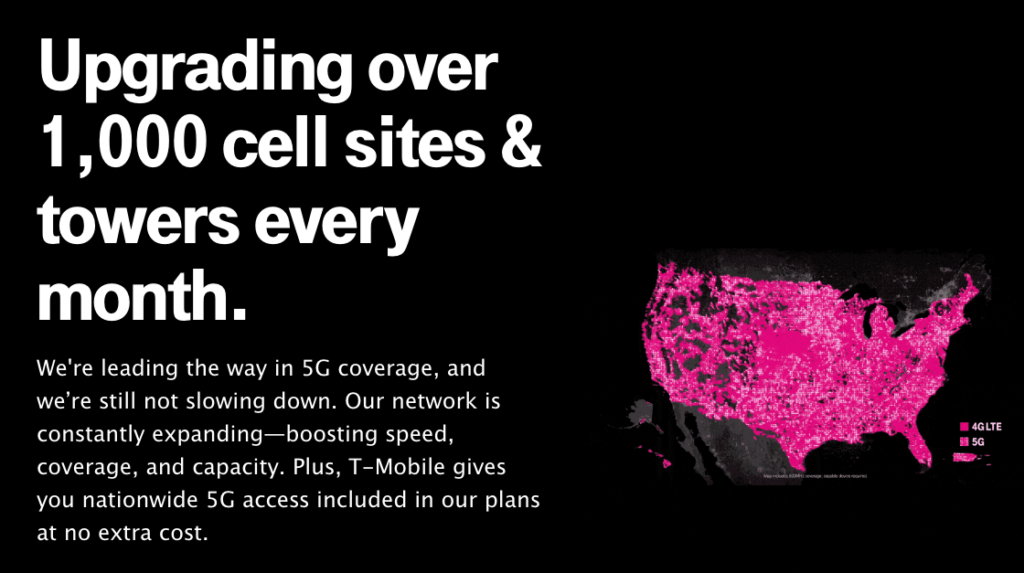
5G Will Increase RF Exposures to the Environment and 5G Antenna Beamforming Exposures Cannot Be Accurately Measured.
A 2019 European Parliament Report “ 5G Deployment : State of Play in Europe, USA, and Asia confirms increased exposure from the 5G/4G Densification stating, “increased exposure may result not only from the use of much higher frequencies in 5G but also from the potential for the aggregation of different signals, their dynamic nature, and the complex interference effects that may result, especially in dense urban areas.” The report points out that it currently “is not possible to accurately simulate or measure 5G emissions in the real world,” stating:
“[T]he 5G radio emission fields are quite different to those of previous generations because of their complex beamformed transmissions in both directions – from base station to handset and for the return. Although fields are highly focused by beams, they vary rapidly with time and movement and so are unpredictable, as the signal levels and patterns interact as a closed loop system. This has yet to be mapped reliably for real situations, outside the laboratory.”
A 2018 study published in Annals of Telecommunications found increased RF-EMF exposure from small cell LTE networks in two urban cities in France and the Netherlands. Researchers measured the RF-EMF from LTE (Long-Term Evolution) MC (macro cells meaning large cell towers) and SC networks (low-powered small cell base stations) and found that the small cell networks increased the radio emissions from base stations (called downlink) by a factor of 7–46 while decreasing the radio emissions from user equipment exposure (called ) by a factor of 5–17. So while the devices themselves could emit less radiation, the cell antennas will increase the levels from cell antennas ( Mazloum et al., 2019 ).
This study shows the increased exposures would be involuntary. We can turn our phones off, but we cannot turn off the antennas in the neighborhood. Birds, bees and trees have no choice.
Please contact me with any questions.
Theodora Scarato
Executive Director, Environmental Health Trust
EHTrust.org
Please see the attached letter from the Environmental Protection Agency (EPA) in response to my specific questions related to the FDA review and to the EPA, CDC, NIOSH and FDA Jurisdiction on EMFs:

